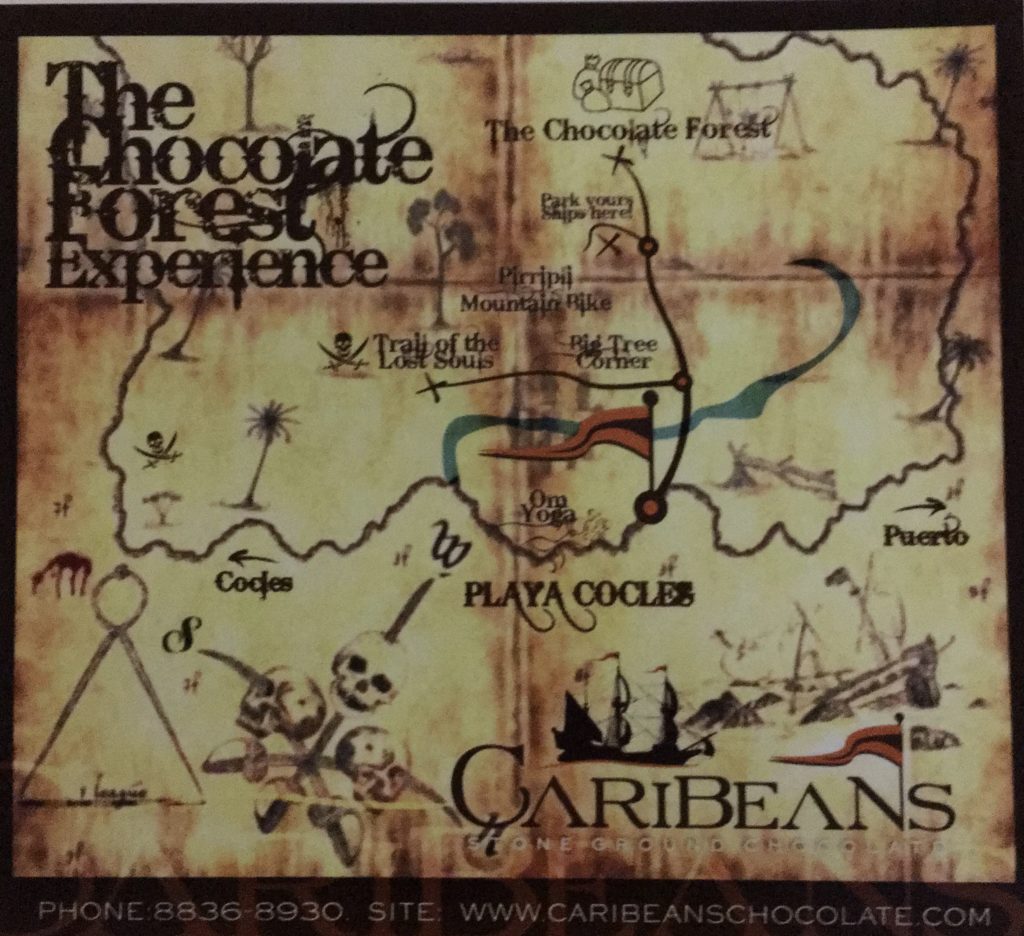
Imagine yourself standing on a mountainside dirt road in the tropics. It’s a humid day, the temperature is in the 80s and the sky is slightly overcast. You are in the middle of the rainforest, visiting an organic, beyond-Fair-Trade cacao farm with fifteen strangers and your travel companion. You’re there to learn more about the source of a small country’s economic resurgence, Costa Rican chocolate.
Now. Imagine you have an upset stomach. The kind of feeling of “I’m in a foreign country and ate something my body doesn’t like,” with continuous rumblings of your intestines and the knowledge that the nearest toilet is a fifteen minute hike back to the store. But wait! This is chocolate you are about to explore.
This is the power of Adventure. (Or maybe it’s the power of prayer. Or maybe the power of Imodium, which I snuck a few more tablets as we headed further up the mountainside.) In that moment, my stomach issues didn’t matter. I decided that this was an adventure I wanted to continue, so I let go of my concerns of a bad outcome (pun intended). Believe me, I had some real fears, and some that were limiting beliefs. Fortunately, all that was released were fears and not anything because of bad food!
CariBeans Mango Walk
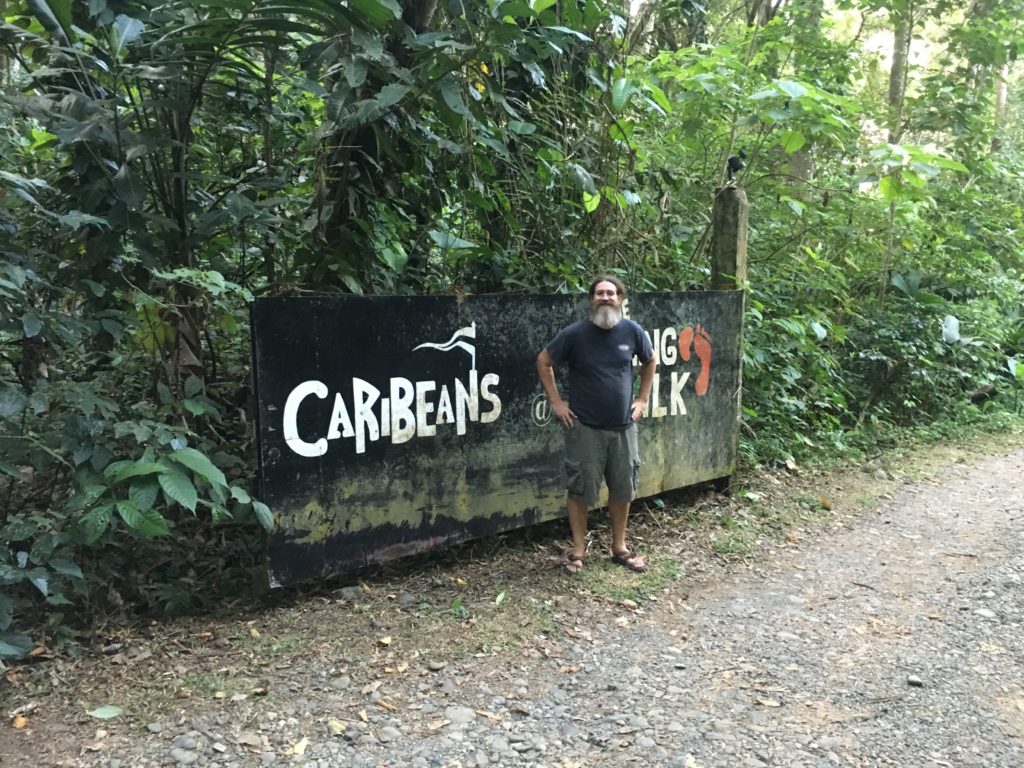
Paul, the owner, in front of his farm’s gate
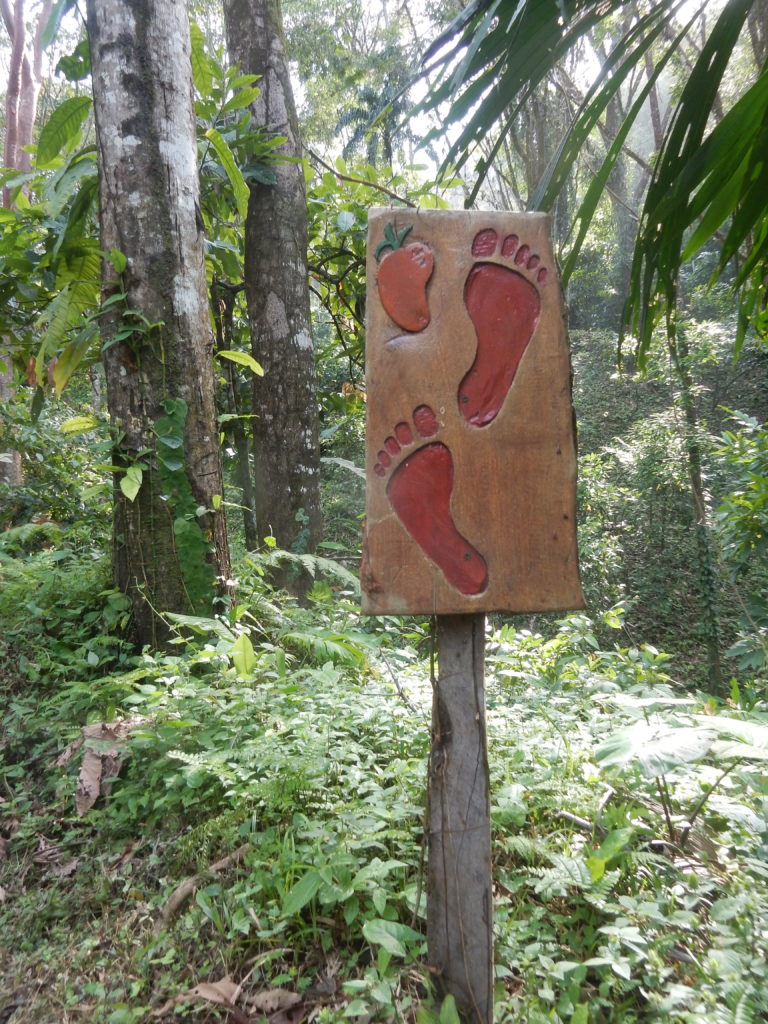
The name of the estate, or finca, is Mango Walk.
CariBeans is on the Caribbean side of Costa Rica, not too far from my friend Kate’s place (my Adventure Partner and I rented her Airbnb Casita Tranquila for this part of our vacation, located near Puerto Viejo, Limon). We had stopped for coffee one morning, and decided to take the tour on a non-sunny, non-beach-type day. The cacao forest property was given its name, “Mango Walk” (Mango Orchard) by early residents because of its many mango trees. They specialize in restoring heirloom trees resulting in a higher quality fruit.
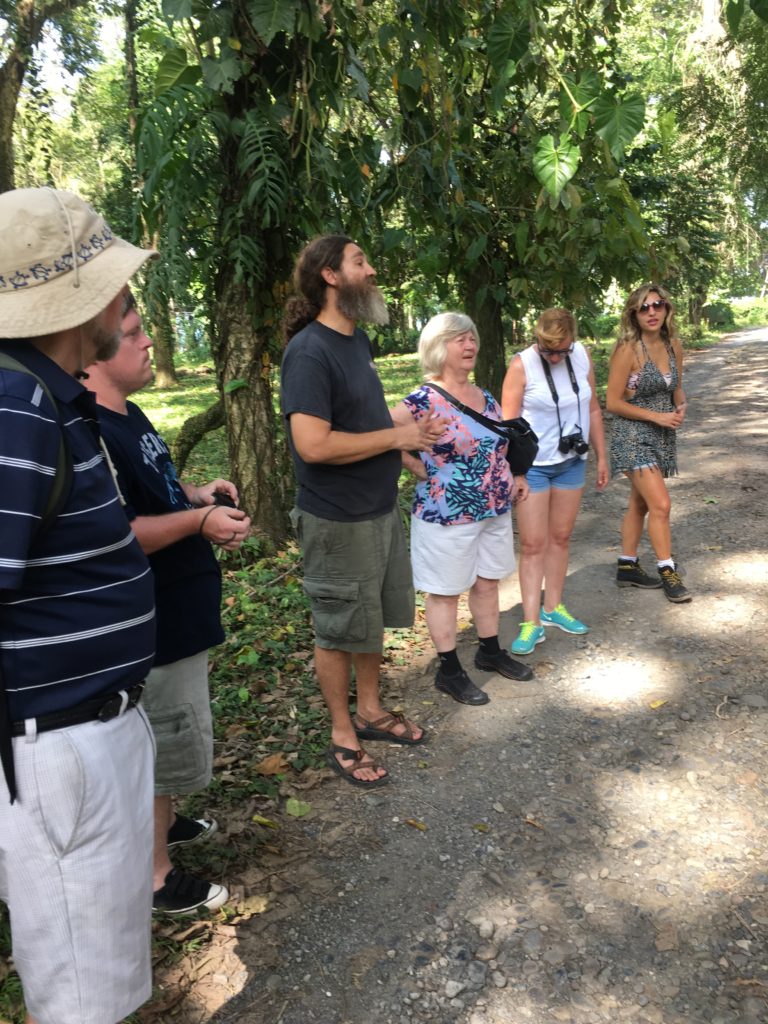
People from all over the globe came to the tour
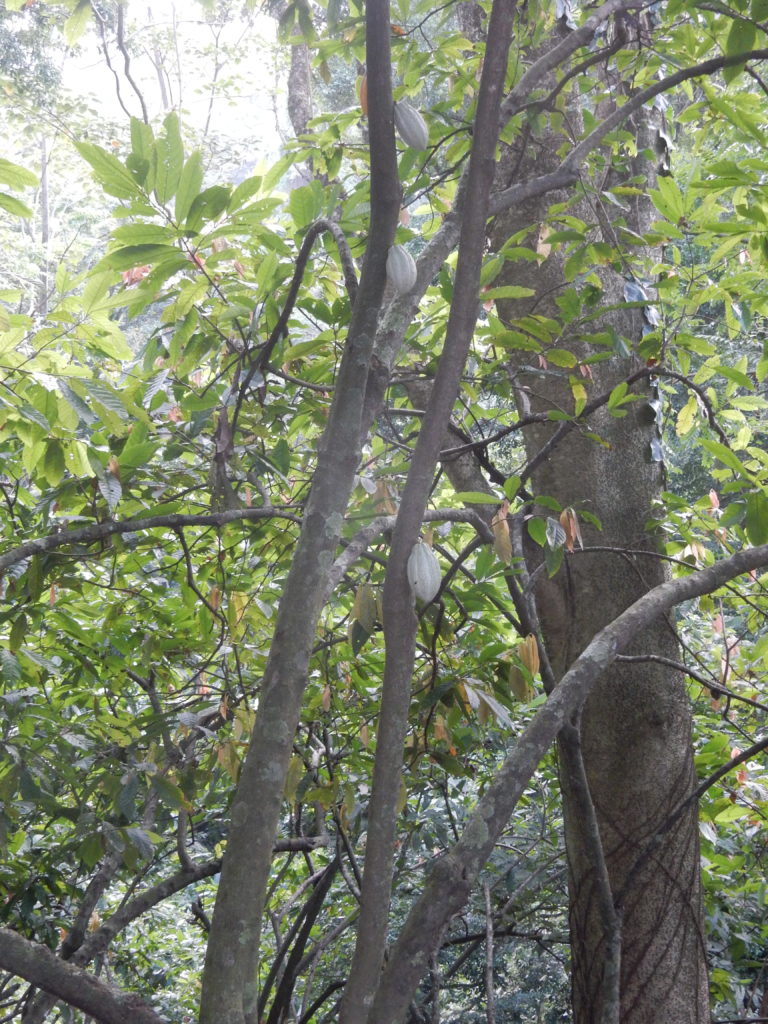
See how the pods are attached to the trees? Not like the way most fruits hang!
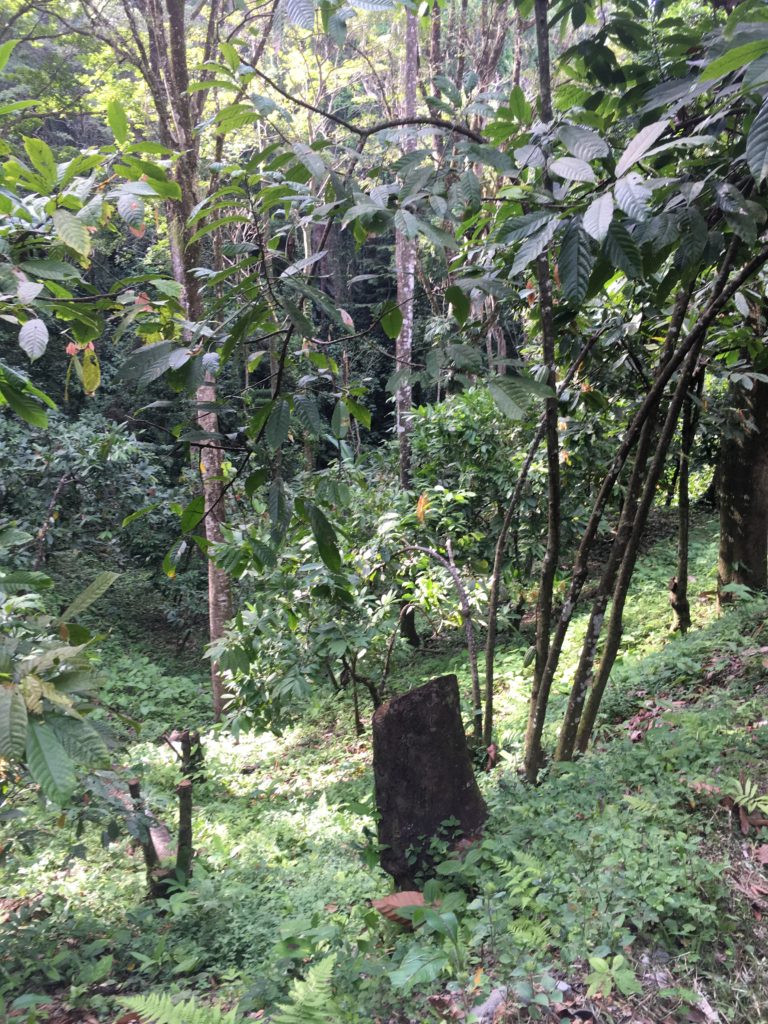
Cacao trees need shade and other forestry to grow. This is why they are better for the planet, they are integrated into the surrounding rain forest.
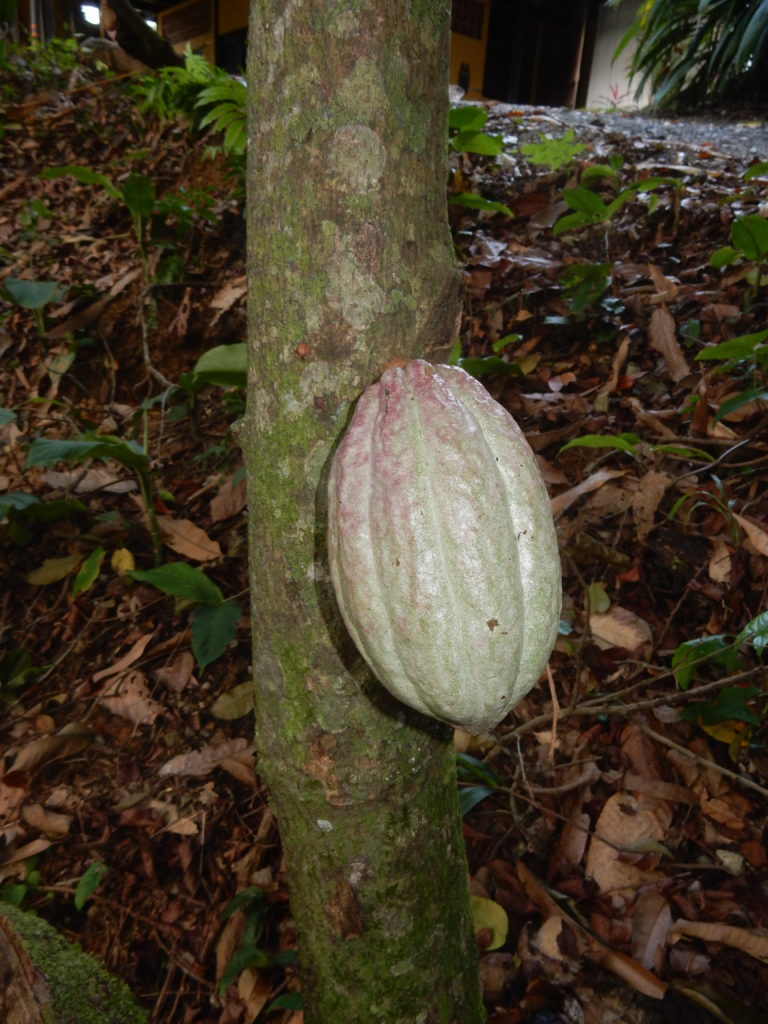
There’s an art to knowing when a pod is ripe as there are so many varieties (even in one finca!) Colors can be green or yellow or red or even shades of purple
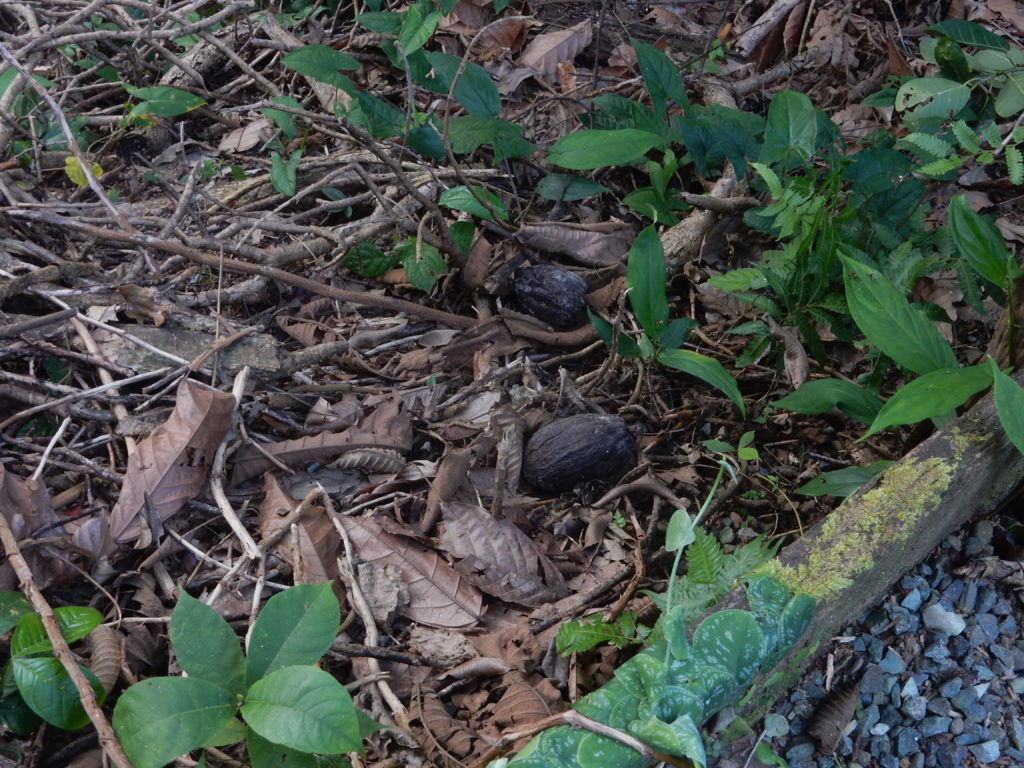
Pods stay on the tree until they have withered. Trees rely on animals to help spread their healthy seeds
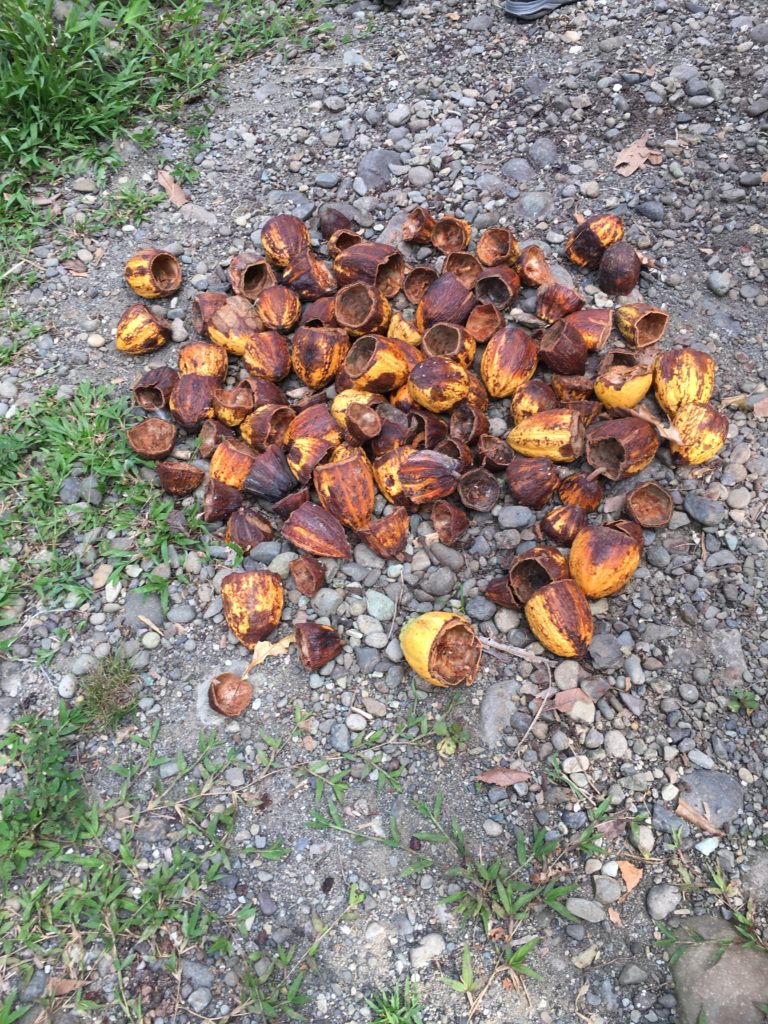
Cacao pods have many other uses (strong fibers), and they also make good compost
Paul, the owner, led the tour. He is someone that you come across who is not only very knowledgeable, but also so comfortable in his own skin that you, too, are comfortable. He explained how he and his wife first came to this part of Costa Rica with a friend, discovered this estate (called finca in Spanish) and decided to learn all they could about cacao farms and making chocolate. Their Adventure turned into a new lifestyle! They hire natives who have generations of experience with cacao groves (and pays them ‘generously’ as he believes their knowledge needs to be incentivized to maintain the craft for future generations). He pointed out younger trees and old “heirloom” growth, and discussed reproduction methods. Identifying when a cacao pod is ripe complicated, and in my opinion should be appreciated as an art. Paul is also really great at pointing out bugs, animals and other natural wonders. Apparently there’s even a waterfall on his property (oooh, that would be fun for a future adventure!)
Pulp Fiction
Climbing to the top of the path, we turned to a small clearing where several structures had been built. This is where the cacao pods are stored, opened and seeds (or beans) separated out. Paul split a cacao pod open and shared the seeds to us, which were covered in a gooey substance (it’s a mucus-like pulp). Seeing a cacao pod split open in a YouTube video is informative, but experiencing it through all the senses is quite memorable! Inside the pod, seeds in the pulp have a slight chocolate aroma, not overwhelming like a chocolate bar, as I had expected. The goo had a shimmer in the tropical light, a luminescence. Paul dug in with his fingers and separated the seeds. He then handed around an open pod so we could take our own bean to eat. They felt soft, like wet velvet. We sucked on the seeds to get the sweet pulp off. We learned that the pulp’s sweetness is actually a fruit sugar, and is loaded in vitamins and nutrients (vitamins E, D, Bs and magnesium; and to a lesser extent than the bean itself, flavonoids, theobromine-the ‘feel good’ ingredient- and caffeine.) After eating the pulp, I could see how Mother Nature invites the jungle’s creatures to help propagate the cacao tree. Monkeys and squirrels that can climb the tree, crack open the pods and drop the bitter seeds so new trees could grow.
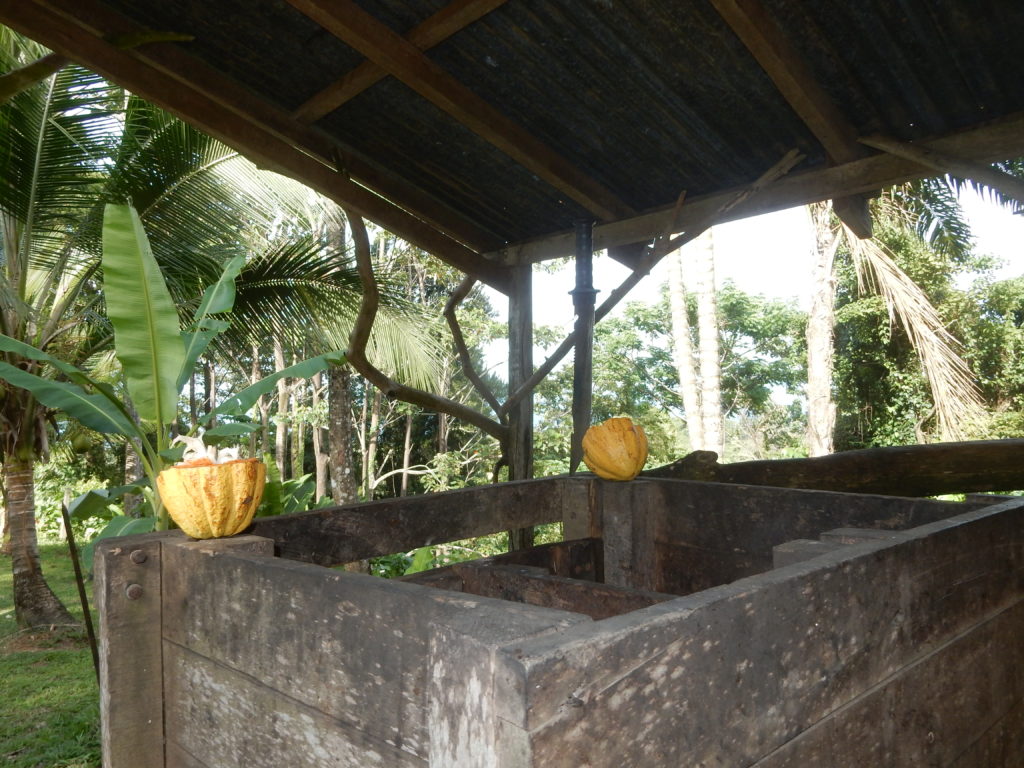
Harvested pods are placed in these bins, before being split open
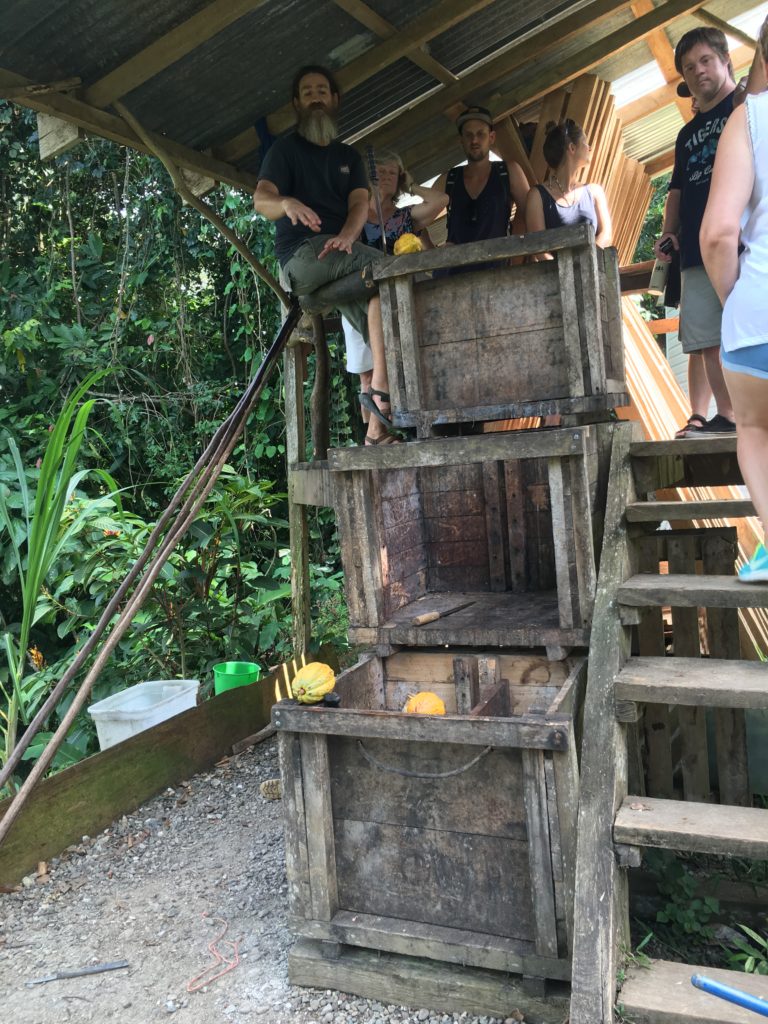
The cacao pod storage has multiple levels
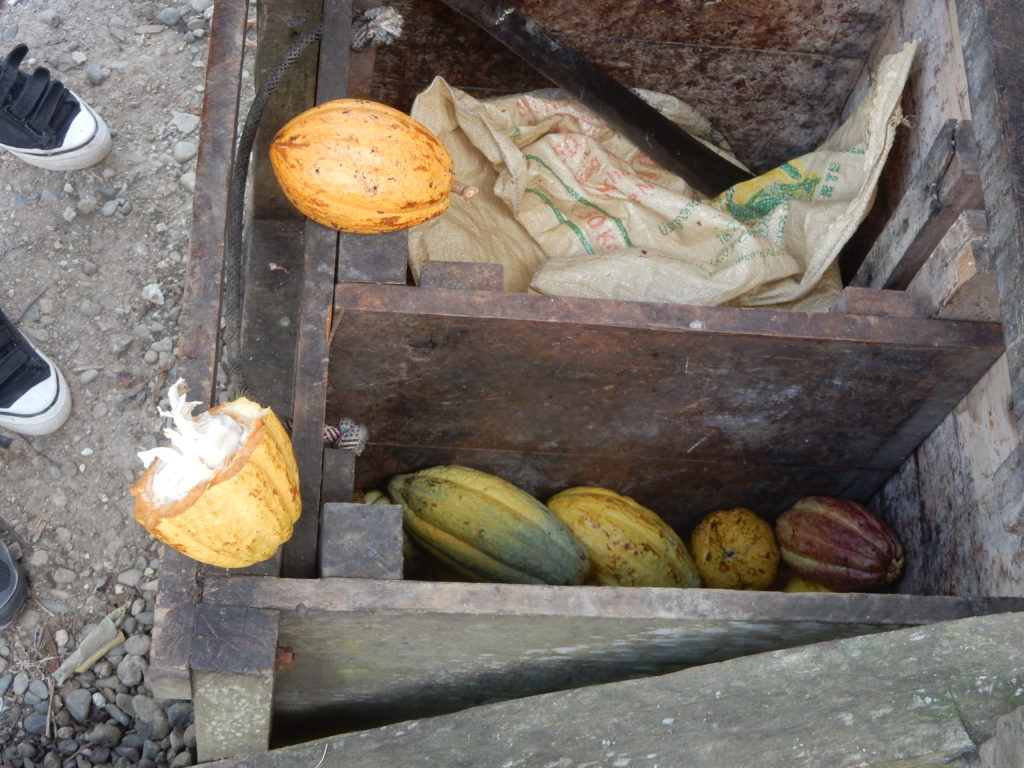
Can you see the machete? It is the most common tool in cacao farming
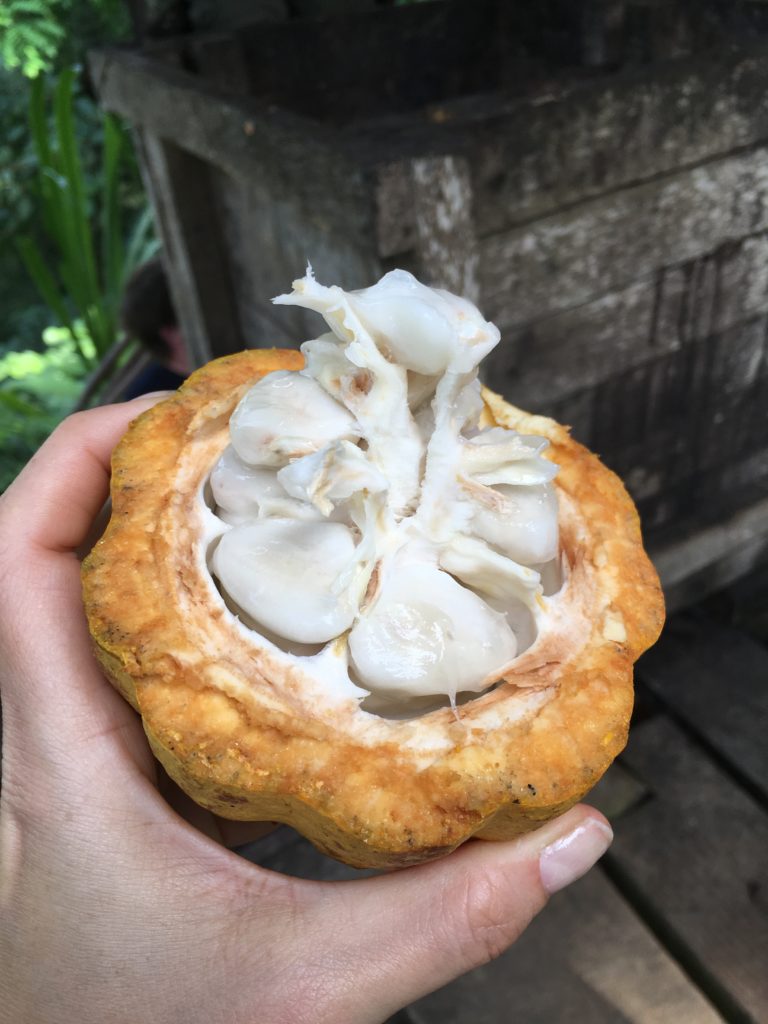
Here are the seeds wrapped in the milky white pulp. We were able to grasp a seed to eat! The pulp is sweet
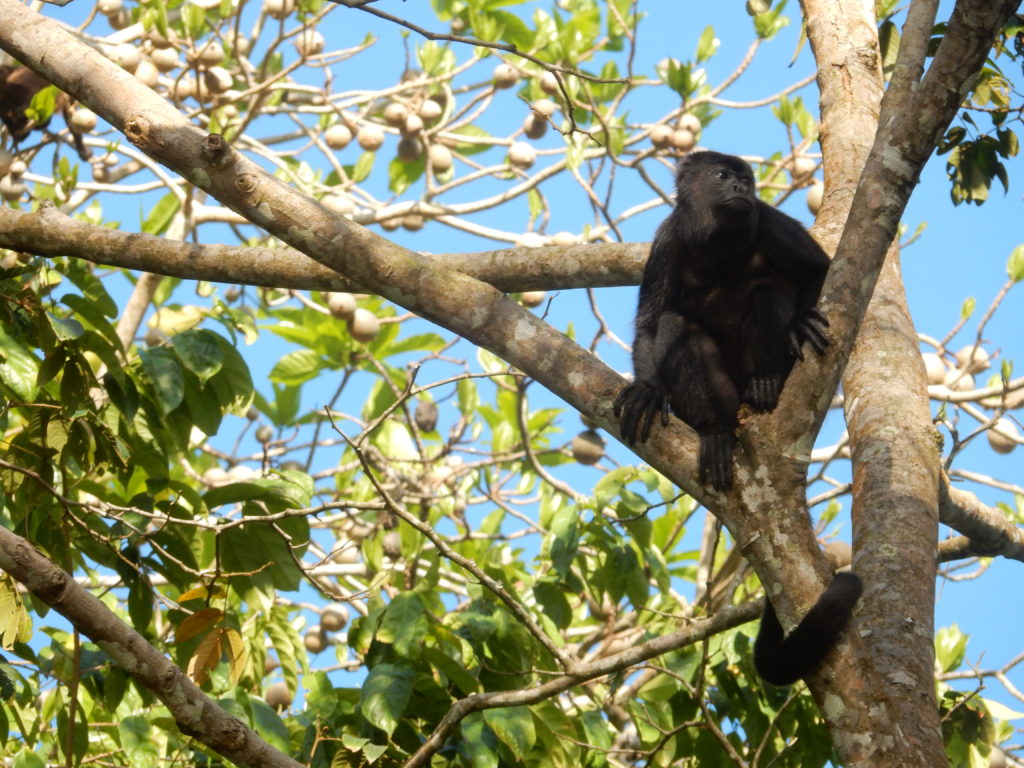
Monkeys are Mother Nature’s helpers in the Fair Trade & organic groves
The harvested cacao seeds are then dried naturally in the sun. This takes some time. Paul has them laid out in stages, as he turns the beans every few days as they dry. The pulp dries into a hard coating, or shell. When I tasted one, I discovered it has a bitter taste. Most of the visitors didn’t like it, but since I already eat dark chocolate and cacao nibs, I was used to the bitterness. It was pretty cool to notice what fresh seeds taste like; something one can’t do any other place than at the source.
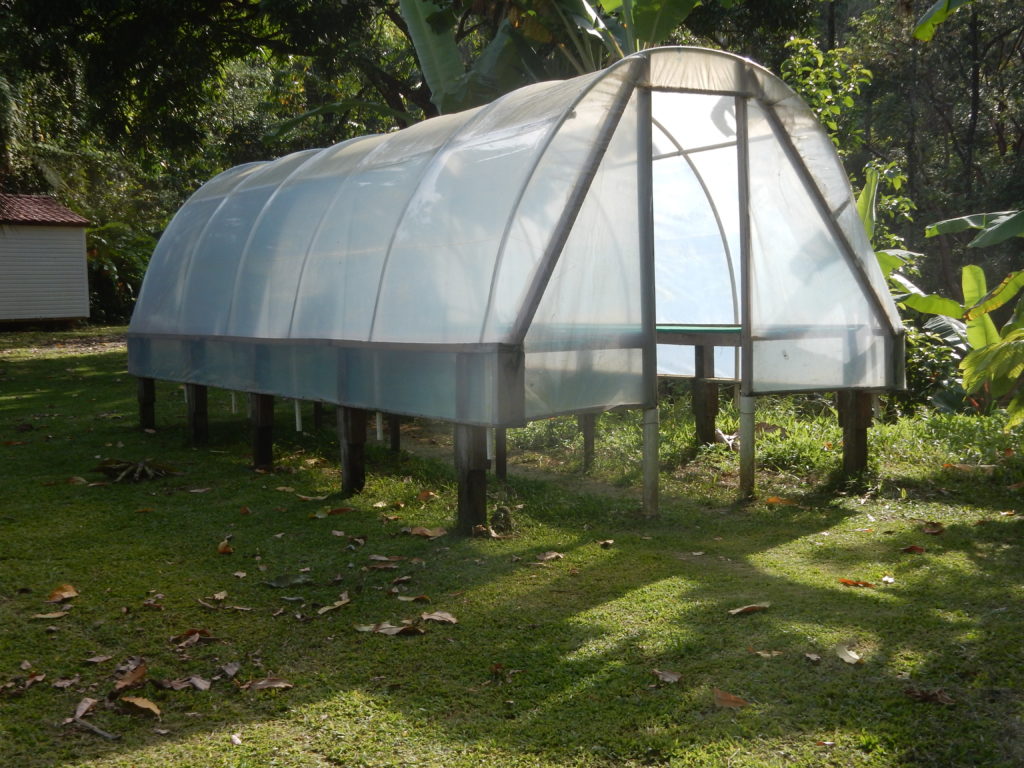
One of the drying tents for cacao beans
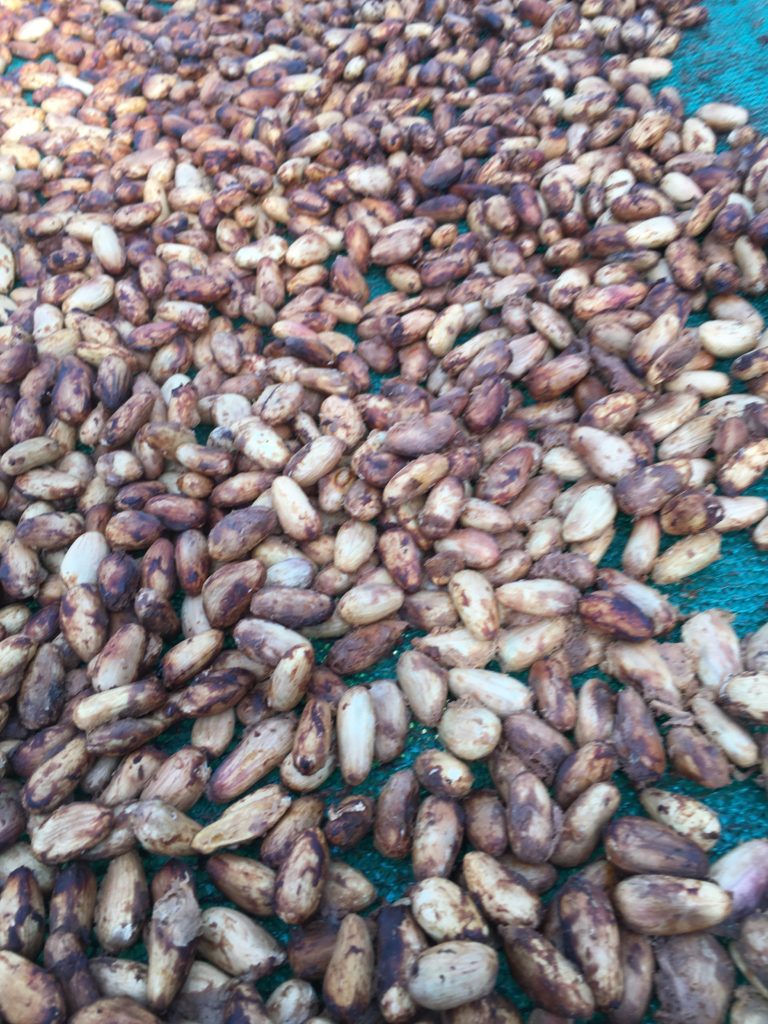
Freshly harvested pods starting the drying process
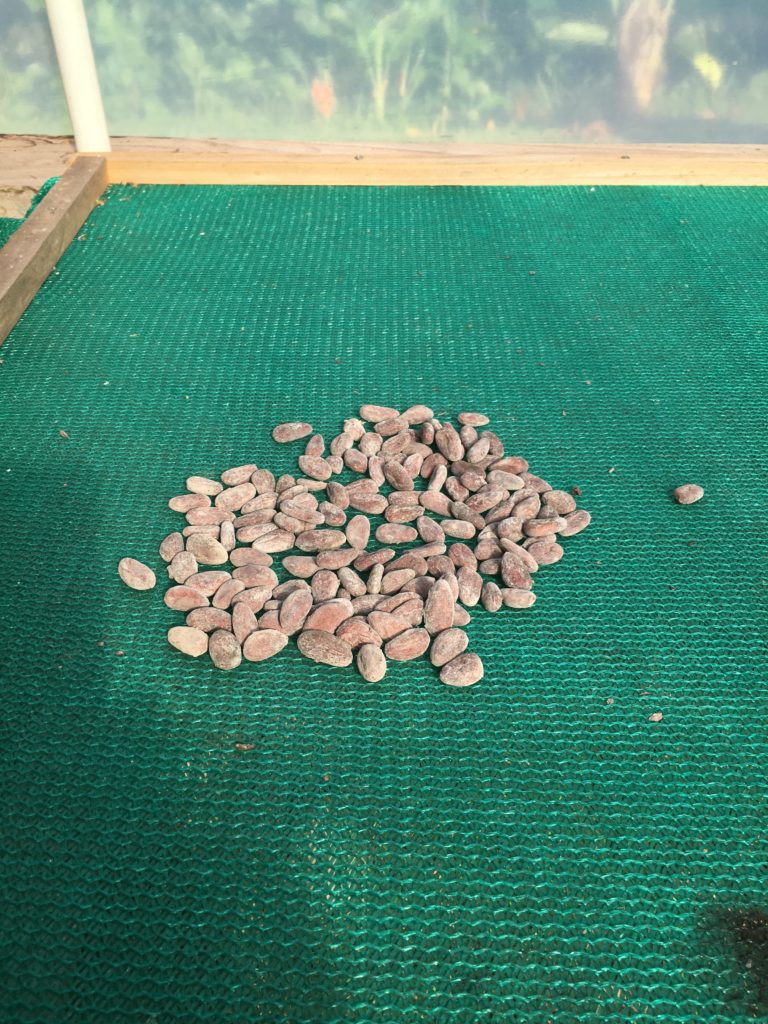
Early in the drying process. You can still see the white from the cacao pulp on the seeds.
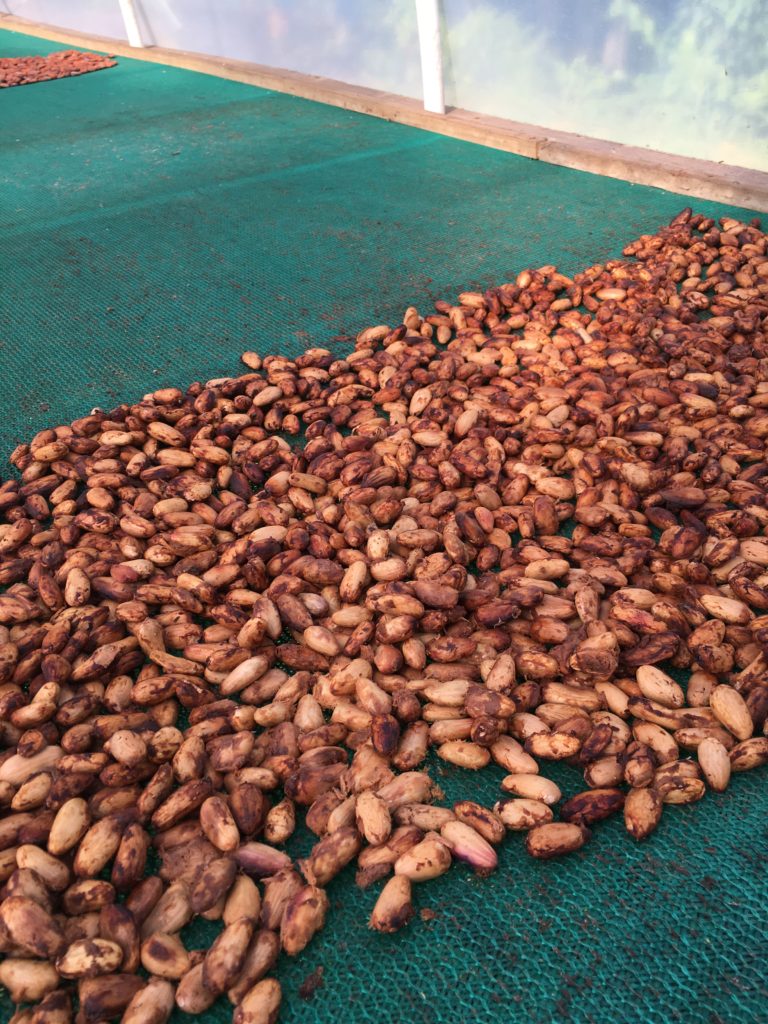
You can see that the beans are starting to get the more familiar cinnamon color
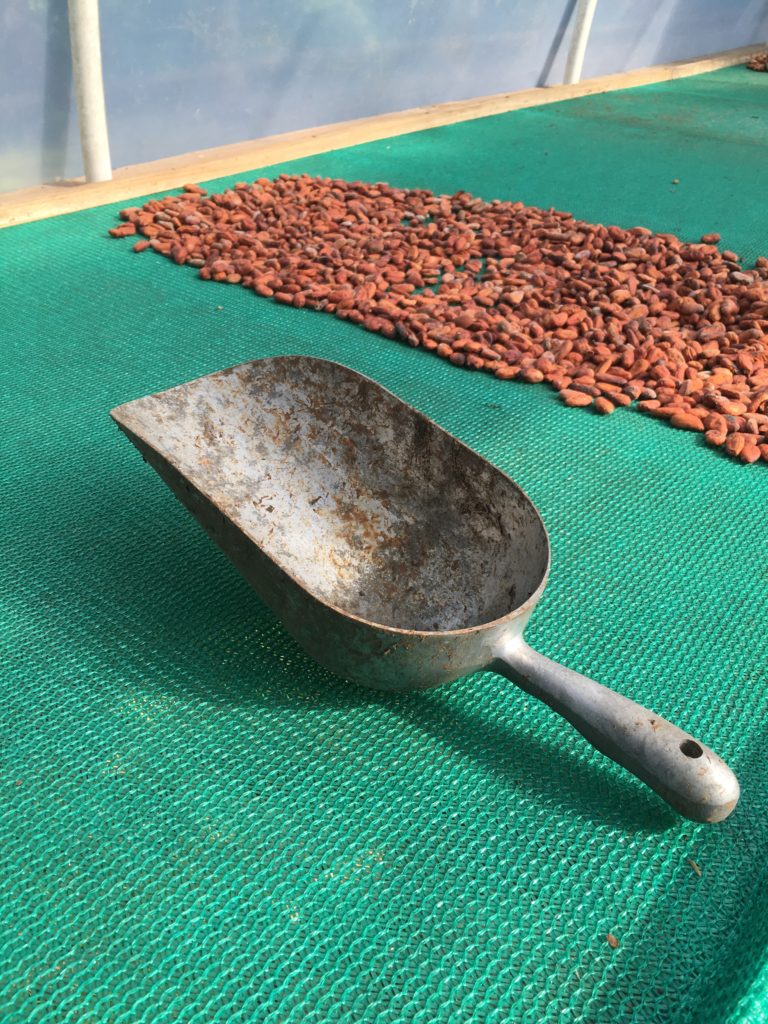
These beans are almost ready to be roasted. Beans flavors can be affected by how many times they are turned during the drying process
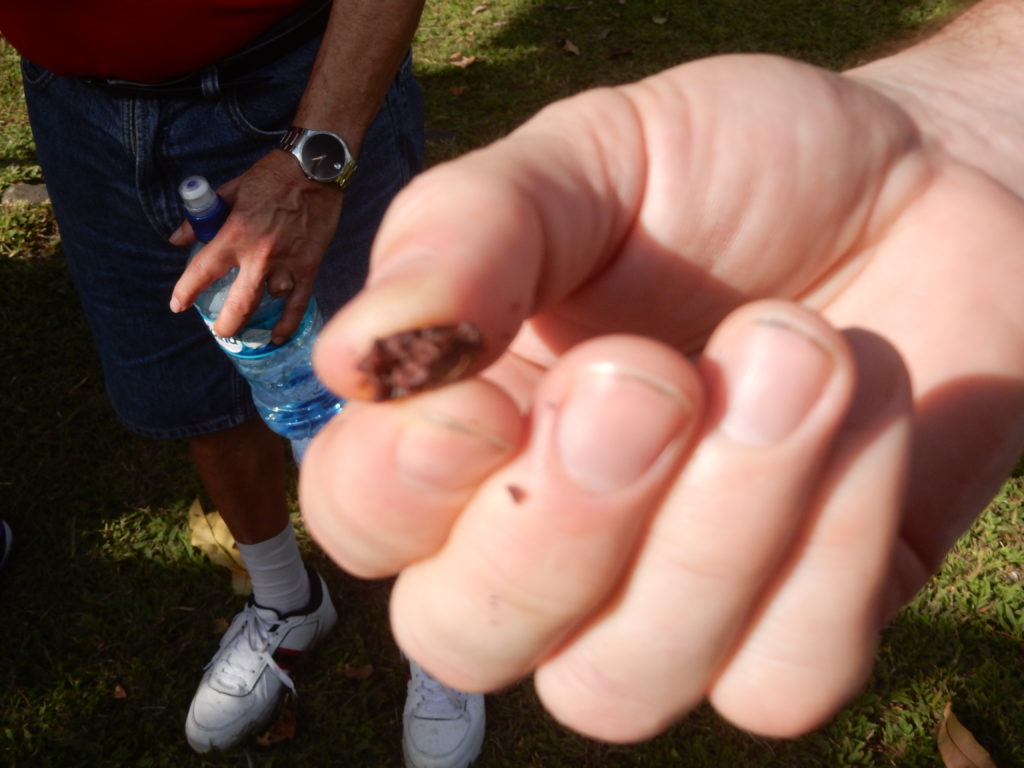
We bit into a cacao bean from the drying racks.
At many farms the seeds are then shipped to be sold wholesale or turned into chocolate at large processing plants. Paul has a mission to give more value to the local indigenous farmers by not only processing beans at his place, but teaching other farmers how to do so as well. He does this so that they can better know the value of their crop. He likens himself to a modern day Robin Hood.
Cacao was “gold”
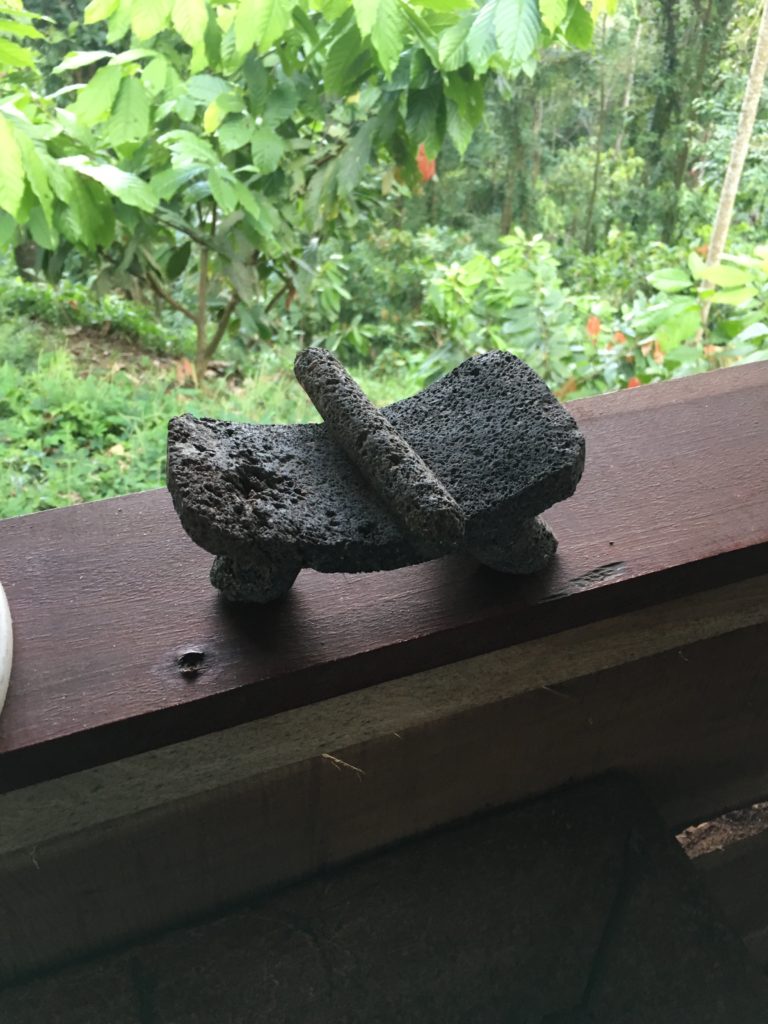
Traditional cacao grinder. Cacao was considered medicinal by the Ancient Mayans
A brief side trip into the history of cacao – and this tidbit is from Paul and other sources I’ve learned along the way. Hundreds of years ago cacao was used as a currency. During the Mayan and Aztec empires, beans were used as an exchange. For example, you could get a copper hatchet for 8,000 beans. The ancient Mayans used cacao in rituals and in a medicinal drink (Xocoatl). I heard that El Dorado, the mythical City of Gold, was actually rich in cacao, not the metal. Another story I want to follow up on is that Captain Morgan robbed Costa Rica of its cacao riches. Spanish sailors used the nibs as a source of energy, not knowing how to process it into liquid. Europeans drank the bitter or lightly sweetened chocolate until the French (via the Spanish wife of Louis XIV) learned to make bon-bons in the mid-17th century. Hard to believe, but it wasn’t until the mid-1800s that the chocolate bar was invented (and in early 1900s when Mr. Hershey made them for the masses).
It is this history of European conquistadors taking Costa Rican “gold” for themselves, that Paul feels he (a person of European descent) is repaying natives by “giving” them education on how to make money off of their own product. His version of Robin Hood, indeed a grand mission.
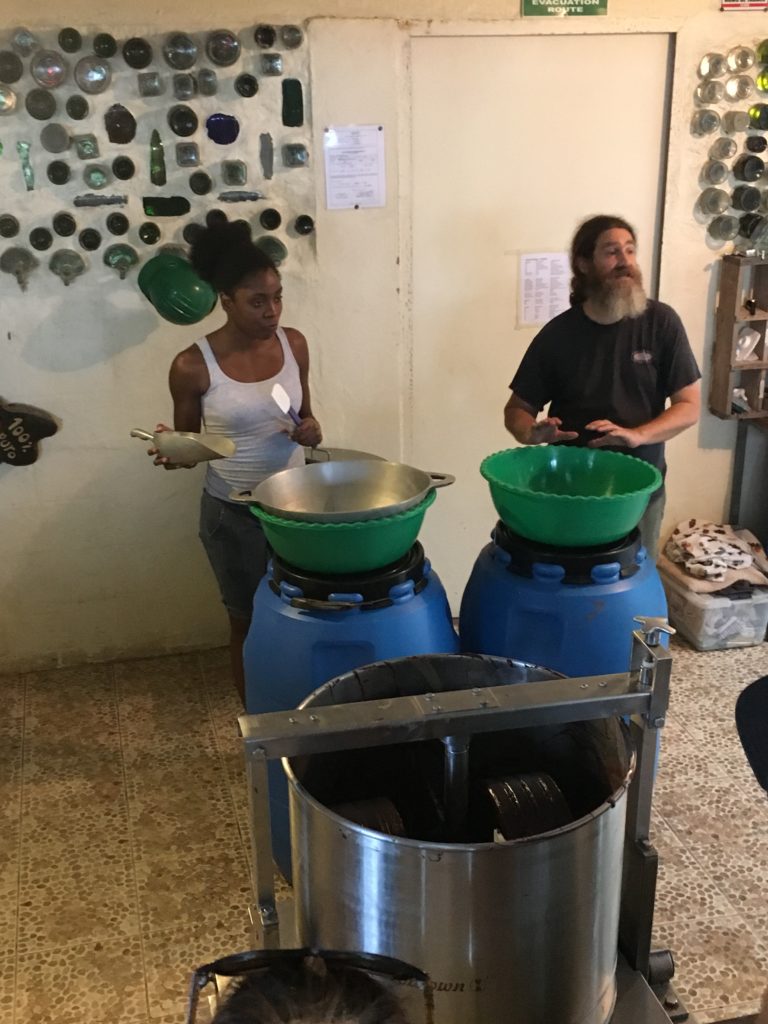
A local BriBri native student assisting Paul in demo of the processing steps
Low Tech Factory
Paul showed us his processing equipment. He thanked his research assistants for helping create the low-tech machinery (“Mr. Google” and “Ms. YouTube” which taught him a majority of what he needed to know). We met one of his interns, a local Bri-Bri native who lives on one of the farms nearby. As she learns, she can help her family understand and bring more value to the beans they sell.
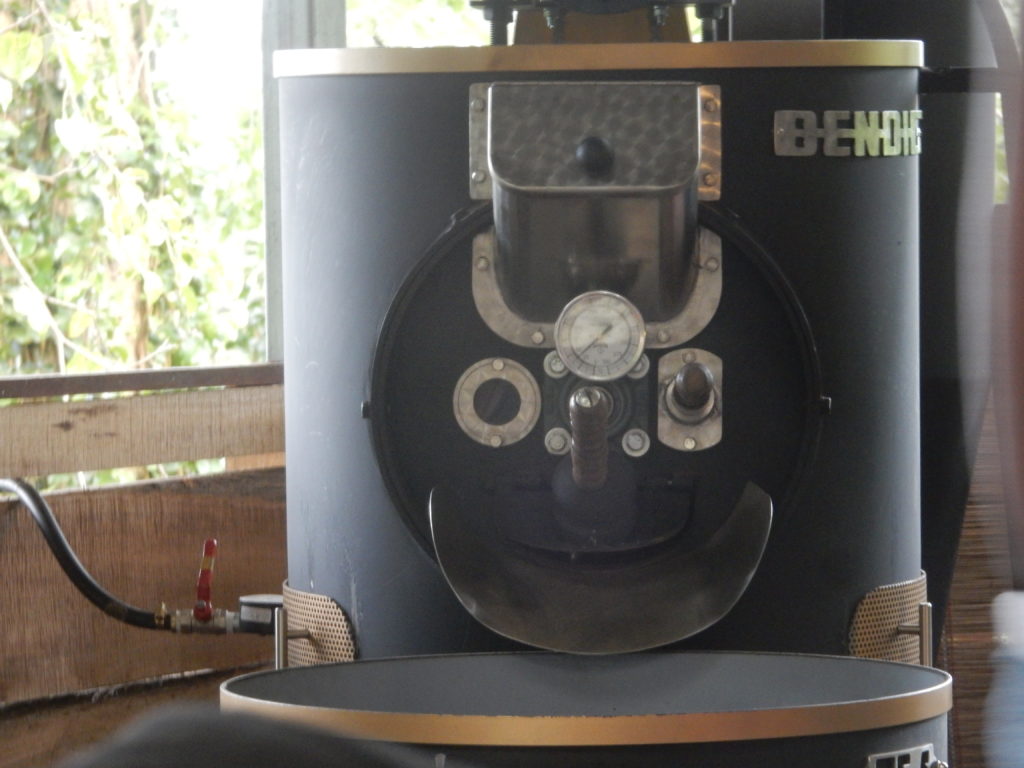
The coffee roaster which doubles as a cacao bean roaster
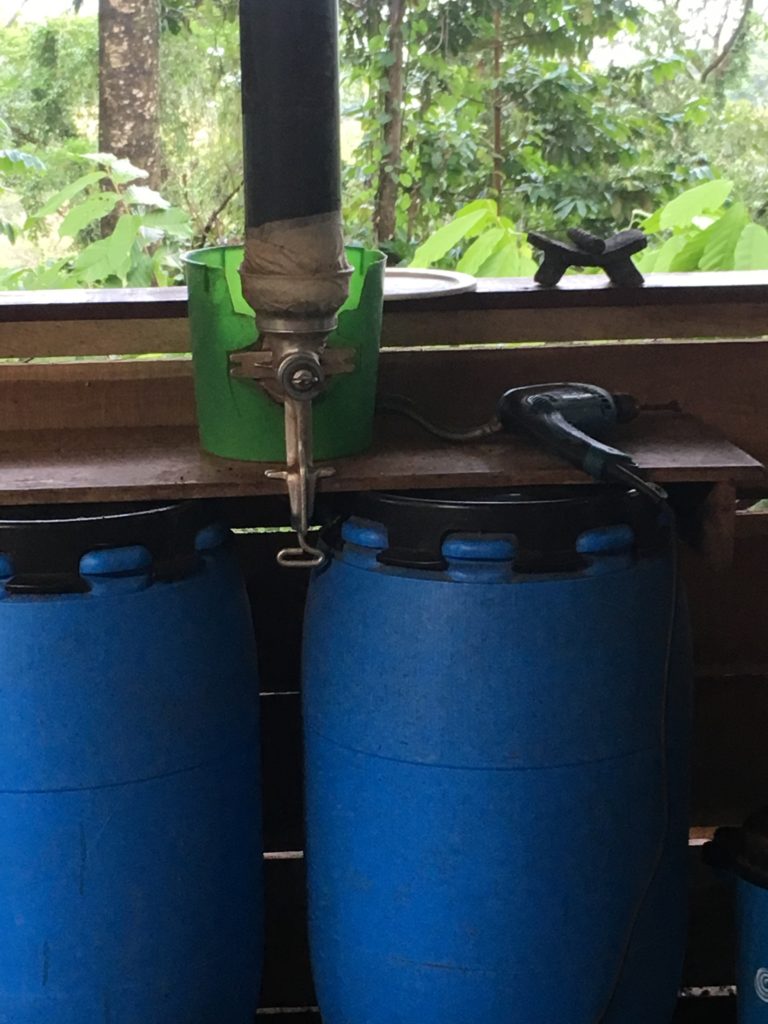
Part of the process of separating the hulls from the nuts
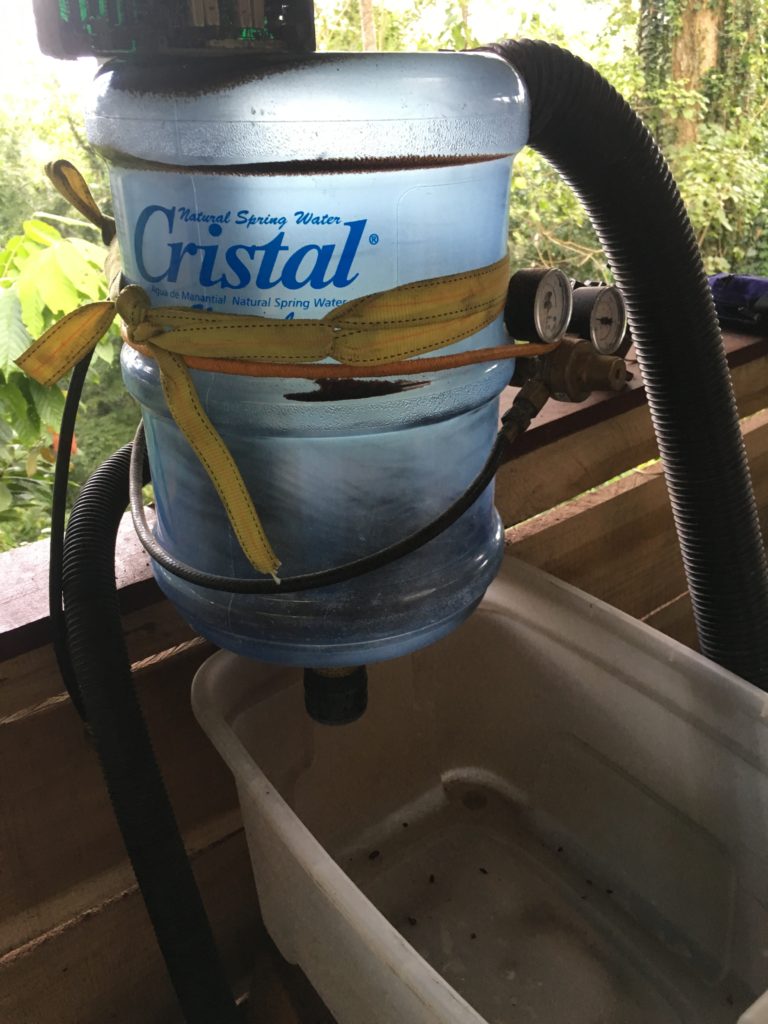
Paul explained how his cacao nut huller was created and it’s part in the processing of chocolate
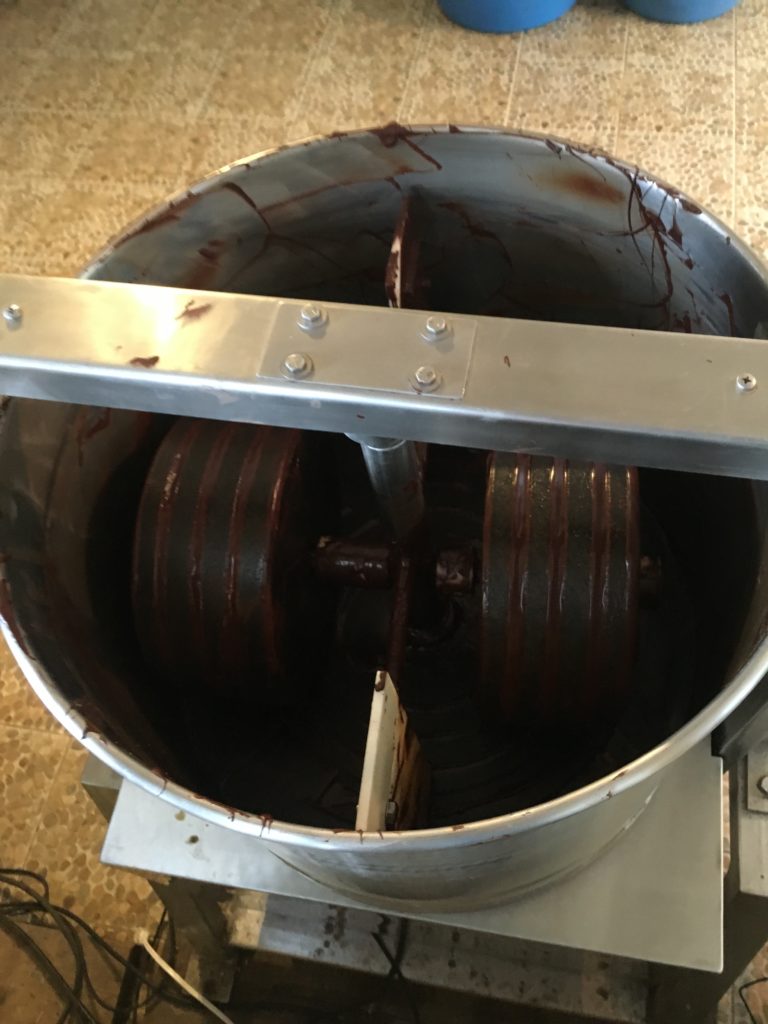
Stone grinder, aka melangeur, for turning cacao nibs into chocolate liquor
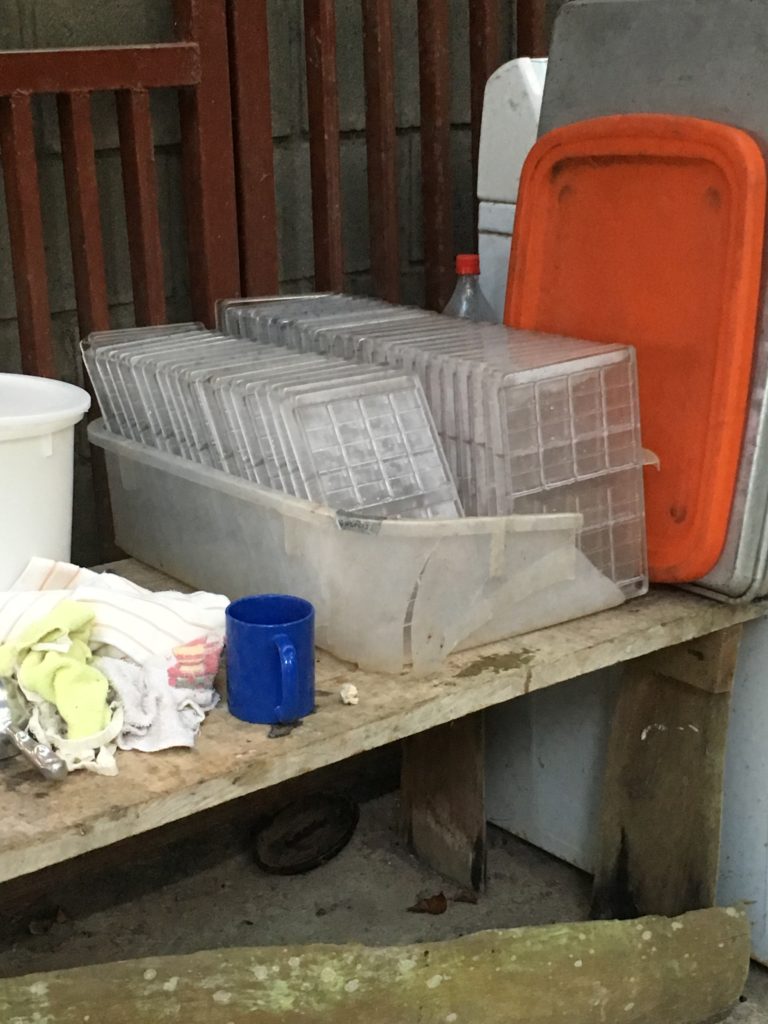
Forms for making bars of chocolate
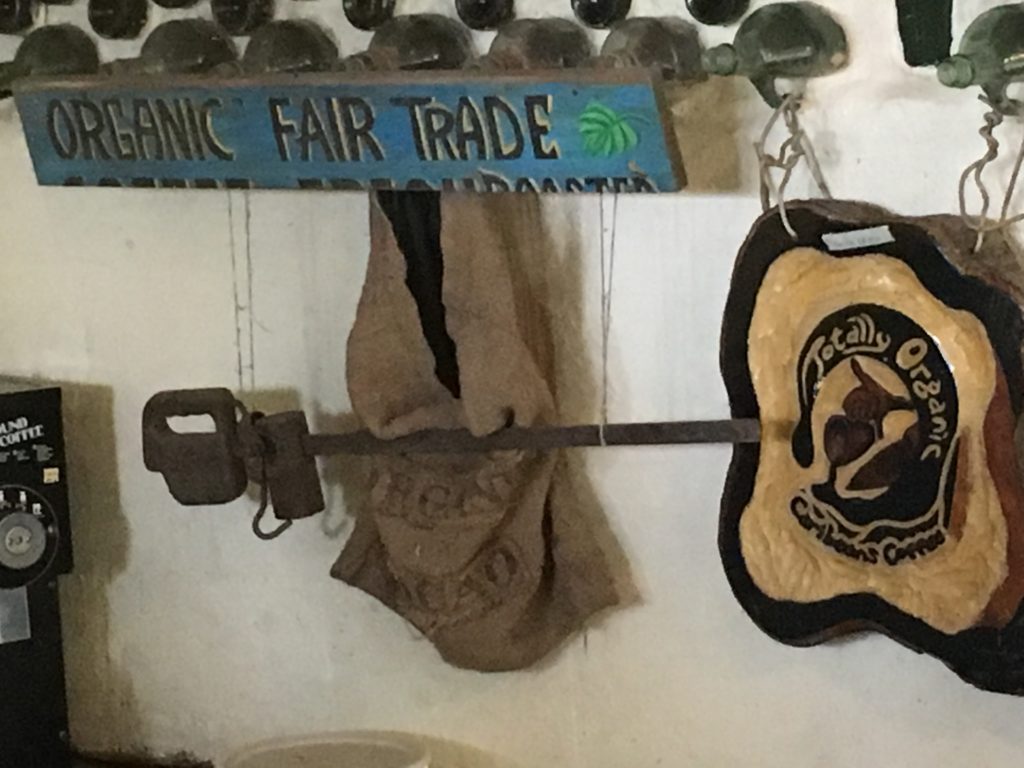
They attend culinary fairs to help showcase Costa Rican artisanal chocolates
Chocolate Forest Tastings
The best part was the tastings. I am forever grateful that whatever had been bothering my stomach had passed. Perhaps the medicinal property of cacao aiding digestion helped? Paul’s wife was there. She had an inner glow that radiated outward and was impossible to miss. She handed out samples as Paul continued to educate us. I found it incredible to learn how the beans grown on different farms offer such a variety in flavors due to what surrounded the trees. I had thought since they were mostly in the same geographical area, they’d be the same. The other great part of the tastings was the view at the top of the mountain. I imagined if I worked here, I’d have the same happy inner glow Paul’s wife does.
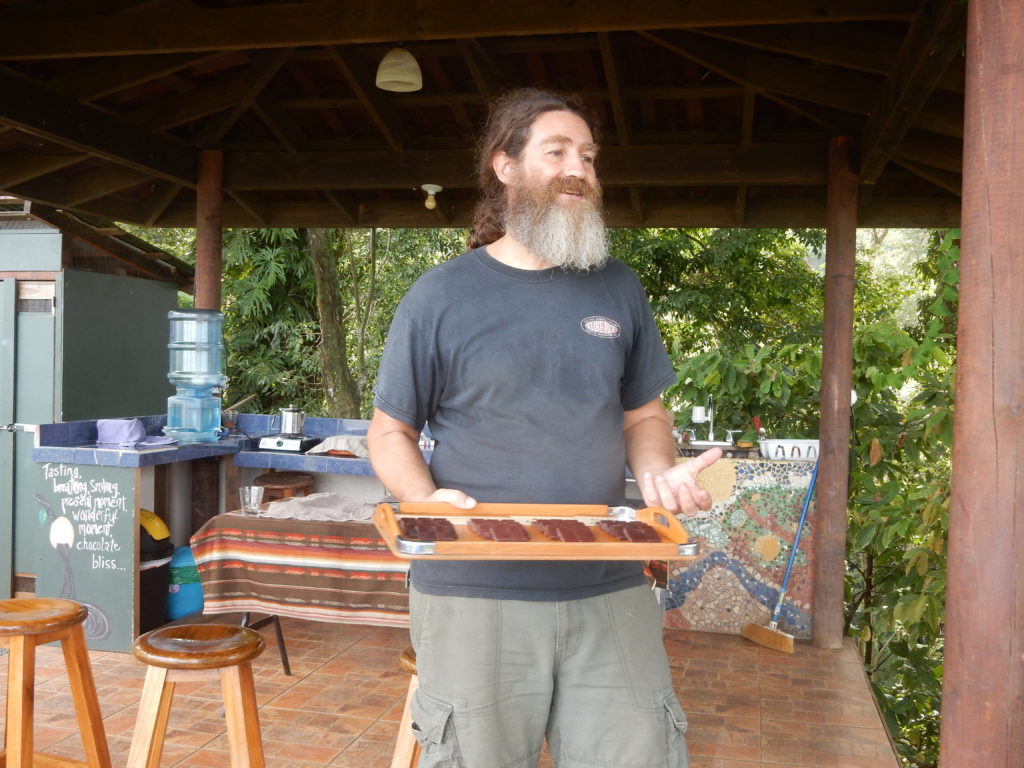
Paul educating us about how different farms’ beans can make chocolate taste different, even when all else is the same
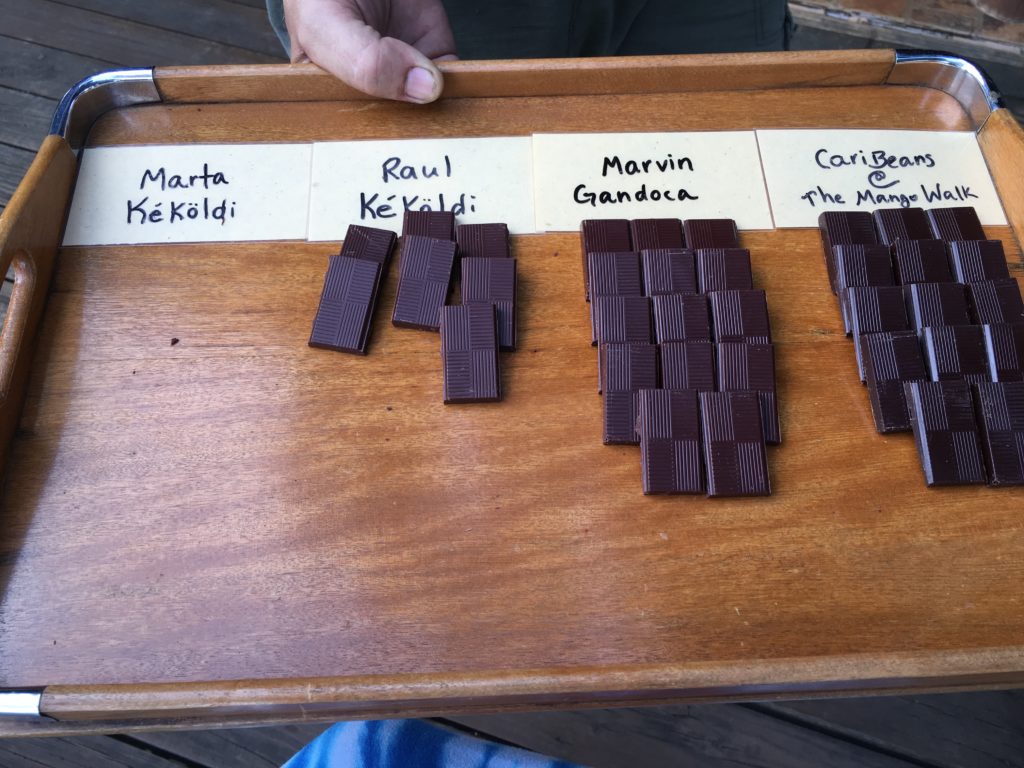
Chocolate made from beans of other local fincas. As you can see, all the samples from Marta KeKoldi have already been eaten!
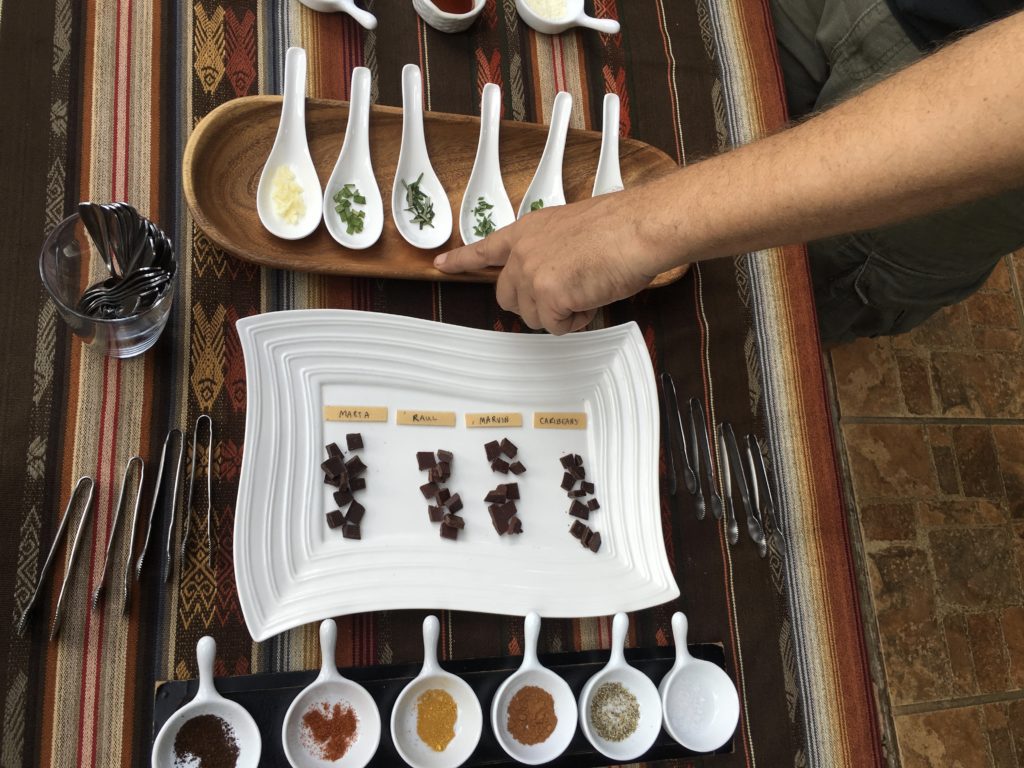
Good chocolate flavors are well complimented by a wide variety of accents (you have to try several of the herbs and spices with the different bars!) I want to experiment more now with unexpected pairings.
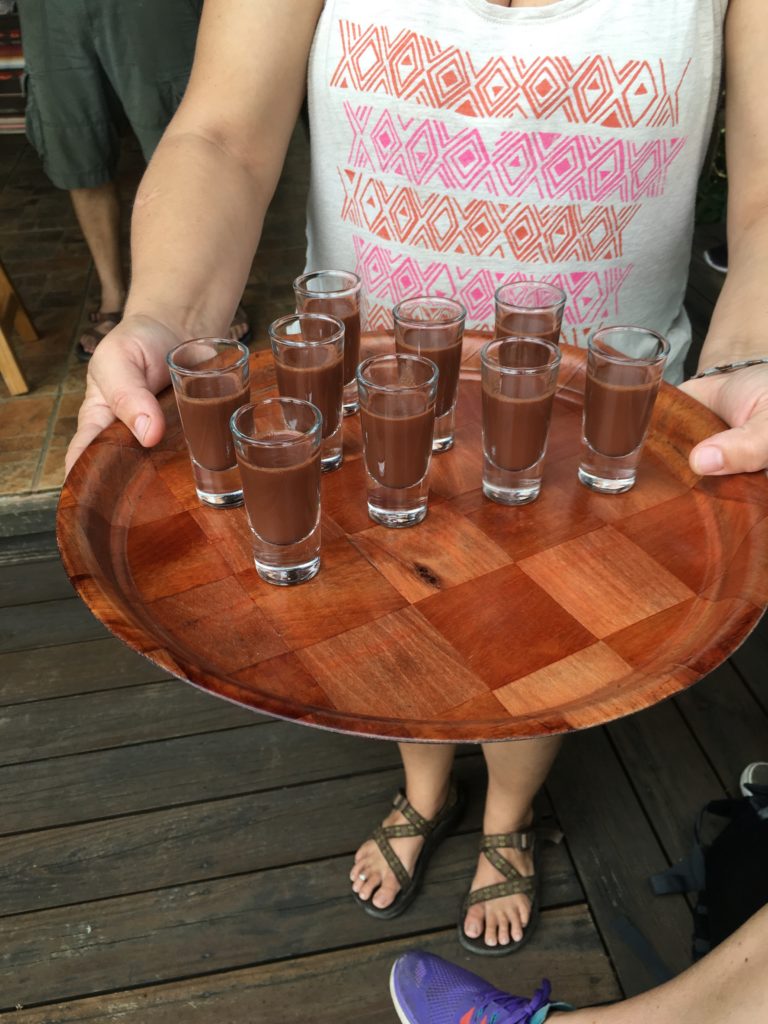
Paul’s wife brought out a magic (chocolate) elixir, or as they call it, an Aztex ceremonial drink. I could get used to this…
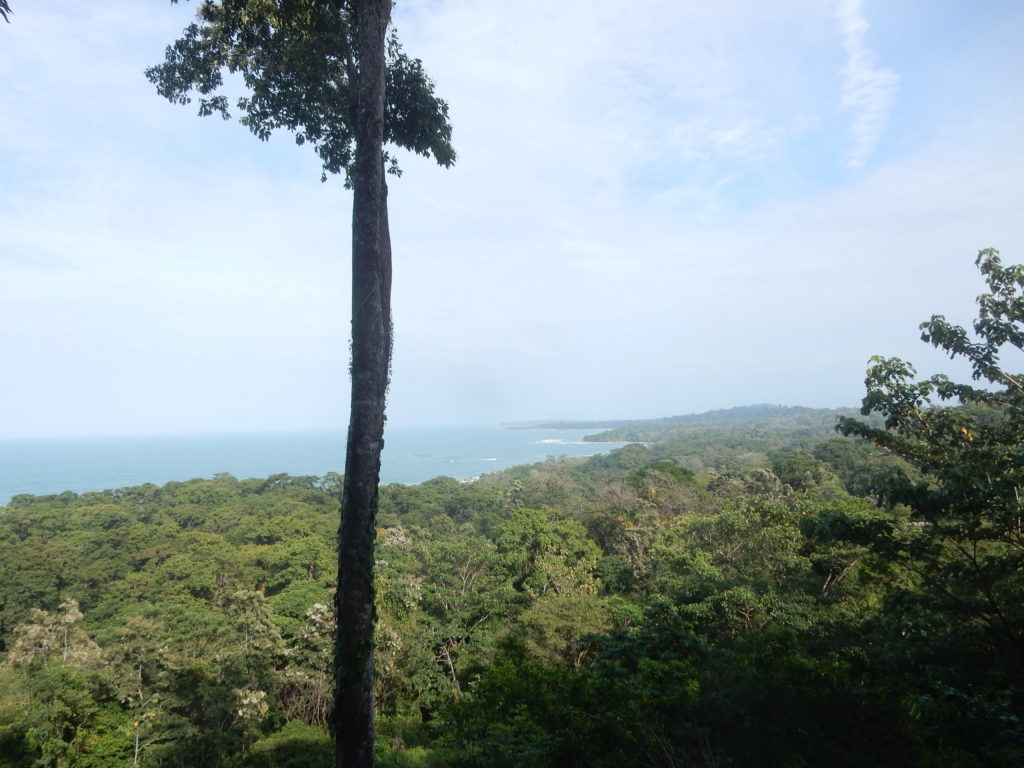
The view (or part of the view) from the deck as we tasted many types of chocolate
After it was all over, I (of course) went to the store and bought many chocolate bars – including the one that they labeled tasting like a Tequila Shot (lime leaves and sea salt make the flavor, not tequila). Back home I eat the raw beans for quick energy boosts (and sometimes have a few more if I am looking for some mood lifting).
Despite my early apprehensions and belly aches, I really enjoyed the tour. I’d like to go back to Costa Rica and explore other fincas. As I learn more about chocolate, I think I’d even like to explore Africa and other cacao growing countries. Maybe I’ll have to get an Adventure Wednesdays travel group to explore with me! They had a sign up on the deck during the tastings. One line sticks with me as how I will always remember this Adventure turning out: Chocolate bliss…
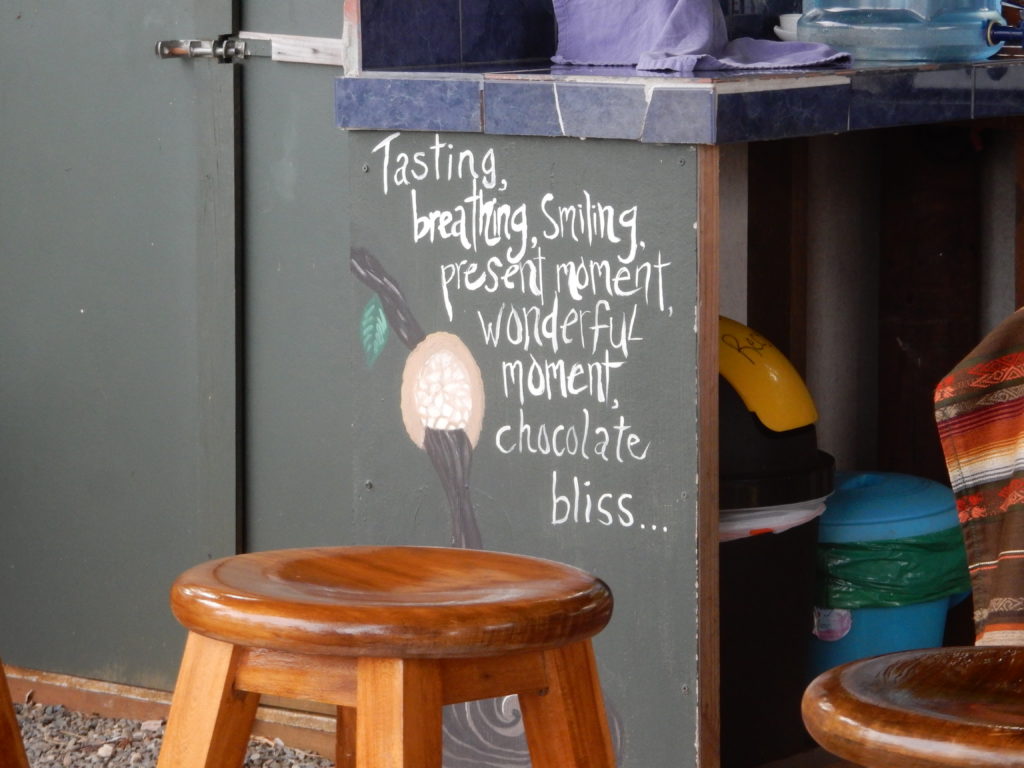
“Tasting, breathing, smiling, present moment, wonderful moment, chocolate bliss…”

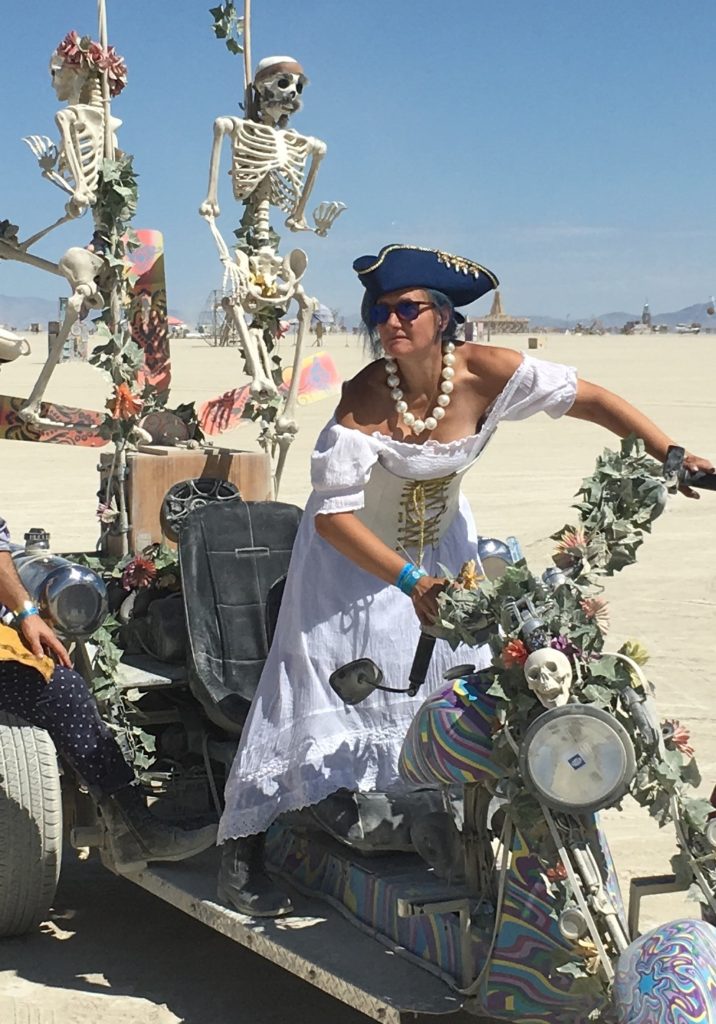 You need more fun & spontaneity in your life, and aren’t sure of next steps or the path to follow. Let’s connect! You could choose a free 15 minute chat, various courses, or even select one-to-one coaching.
You need more fun & spontaneity in your life, and aren’t sure of next steps or the path to follow. Let’s connect! You could choose a free 15 minute chat, various courses, or even select one-to-one coaching.
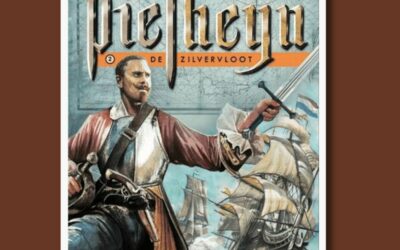

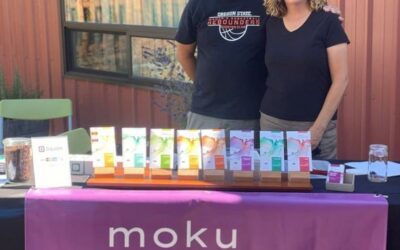
0 Comments